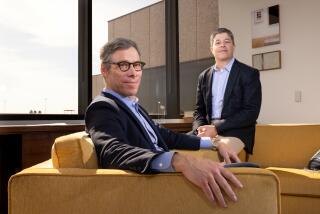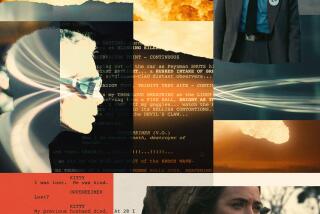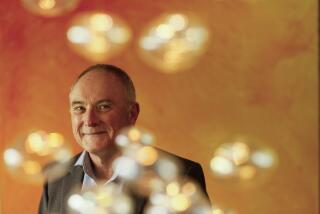Directors discuss the work and play angles
In the costly and time-intensive discipline of animated filmmaking, every movie comes with high stakes. Five directors who recently came together for the first Envelope Animation Round Table discussed the artistic and business demands of the medium. In a conversation at the Los Angeles Times, Mark Andrews (“Brave,” with Brenda Chapman), Chris Butler (“ParaNorman,” with Sam Fell), Rich Moore (‘Wreck-It Ralph”), Peter Ramsey (“Rise of the Guardians”) and Genndy Tartakovsky (“Hotel Transylvania”) tackled topics such as how they pitch their ideas, approach voice actors and handle the limitations that come from playing strictly to family audiences.
VIDEO: The Envelope Animation Round Table
Here are edited excerpts from the conversation:
What’s your story-pitching style?
Mark Andrews: People get caught up in enthusiasm, right? And your own passion for it. I was telling Andrew [Stanton] this one idea that I had. And he loved it. And then later on when I had a formal pitch, he took me aside, and he’s all, “That was awful. When you’re telling me a story that you know from your heart, you cut out the academics; it just comes out organically. That’s what your pitches need to be.” So I went, OK, don’t prepare. And that’s what I do now.
Genndy Tartakovsky: In my situation, it was very unique because it was an abused property. The story crew’s beaten down, the executives, everybody. I have to come in there and have conviction. That’s the only thing I can have to win everybody over, is to pretend that I know what I’m doing and convince everybody that I’m doing it. A lot of live-action directors are very strong-minded and they don’t get bullied. They fight. And so I felt like I had to do that. I had to stand up for what I believed in even if I’m not even there yet story-wise.
How do you filter all the different creative voices coming at you with notes — executives, your story team, test screening reactions?
Peter Ramsey: I was pretty secure in what I saw for the film in terms of the tone. That was the thing I held on to. I said, “Let’s not do a satire. Let’s not make it a parody. Let’s play with that idea of taking this seriously, which, luckily, writer David Lindsay-Abaire was thinking along the same lines. Staying true to that was enough to keep everybody else at bay.
If you’re making an animated movie in the U.S. marketplace, almost by definition it has to be a family movie. Did that ever create dilemmas for you?
Chris Butler: Every day we talked about it. Where’s the line? Are we crossing it? How far can we go? The interesting thing for me was that quite often when we would screen to kids, the kids are fine. It’s their parents that were like, “They’re scared.”
Andrews: I want to give my children, as a parent — I want to give them the tools to say, look, it is scary and you’re going to survive. Trust the storyteller. We’re not going to steer you wrong. I reference “Bambi.” I reference “Dumbo.” There are scary Disney movies that people have grown up with.
Tartakovsky: I think it’s an issue with the animation industry, where everybody’s trying to make one movie. Rather than, we can have a kids’ scary movie or an action movie and a stupid, silly comedy, everybody’s required to make one type of movie. If somebody could break free and make something different, it could be just as successful but just different.
Rich Moore: I said in the beginning I’m making a movie about video games. They have violence in them. There’s a lot of conflict. There’s a lot of stress and action. So this is going to be a PG film. We’re not going to be able to make a movie about video games and rate it G. And then it was just a balancing act of, OK, there can be gunplay. But it’s all science fiction, and there’s a certain amount of levity to it.
VIDEO: The Envelope Screening Series
How did you approach directing your voice actors?
Moore: If the audience is going to see John C. Reilly and Sarah Silverman for the first time together in a movie, they want to feel the chemistry between them. So we [got] them in the room together to kind of play off one another, as opposed to usually in feature animation it’s one actor by himself recording. The actors could look into each other’s eyes, and I would let them step on each other’s lines so we could have that real spontaneity in the performance. Because the animation process is so long, it just wrings spontaneity out of every inch of it. I feel like my job was always to make it appear to the audience that they’re watching this thing happen before their eyes.
Ramsey: Alec Baldwin, he’s North, our version of Santa Claus. The Russian accent — at first he was like, “Am I from Minsk?” He just didn’t want to sound like Boris Badenov. The amazing thing was how well he knows his instrument, his voice. He’d go in and slip into character and riff a little. But he was very attentive to the line as written because it was David Lindsay-Abaire, a playwright, and he had a lot of respect for that.
Will we see a 2-D animated feature made by a Hollywood studio in the next five years?
Butler: There’s a lot of smaller-scale projects. And what’s great about them is that they are tackling subject matter and storytelling that’s completely outside of what we’re trying to do. And you see that coming up actually in the Oscar submissions every year.
Tartakovsky: I’ve been pitching 2-D movies for seven years. The one thing that I always run up against is that most studios want to make these movies which are big budget with big reward hopefully. And I’m trying to convince them, well, in live action you can have a small movie that makes a sensible amount of money. Why can’t we make a $10-million movie? And you make $30 million. Why can’t we make a smaller animated film? My perfect scenario is “My Big Fat Greek Wedding”: $5-million movie, $235-million box office. Most studios are making less movies. And so the risk is great.
Andrews: Because here in the States, it’s only for kids, it can’t be for adults.
Butler: Increasingly over the last 20 years, parents have become much more conservative as to what they think their kids should be watching. And not always in the right ways. A lot of movies have just become for parents a means for them to occupy their children.
Moore: That reminds me of a test screening we did on “Wreck-It Ralph.” No one complained about it being too violent or too scary. But there was a note that we got from one lady because we have two characters kiss. She said, “Well, that kiss lingered just a little too …” It’s like, well, you could blow people away. Two people kissing? A man and a woman kissing?
Andrews: We didn’t get anything for the naked butts in “Brave” at all. We got, where’s the prince? Why can’t there be a love interest for Merida? That’s what people missed the most. They’re so chained down to these things that have been in place. Conventions. Break the chain.
Moore: The key to that is to turn the conventions on their head. I don’t think you can break them. You need to start by spinning them a little bit.
MORE COVERAGE
PHOTOS: Memorable red carpet moments
VIDEO: Highlights from the Envelope Screening Series
More to Read
From the Oscars to the Emmys.
Get the Envelope newsletter for exclusive awards season coverage, behind-the-scenes stories from the Envelope podcast and columnist Glenn Whipp’s must-read analysis.
You may occasionally receive promotional content from the Los Angeles Times.







